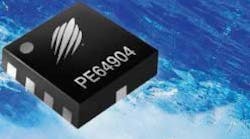Innovative components that allow engineers to rethink the way they design RF/microwave circuits are rare. But the PE64904 and PE64905 digitally tunable capacitors (DTCs), courtesy of fabless semiconductor company Peregrine Semiconductor, are two such components, creating a new slate of possibilities for design engineers working to about 3 GHz. The two DTCs, which differ by their three-wire SPI-compatible and two-wire I2C-compatible control interfaces, respectively, can be used in series or shunt configurations, each yielding a different capacitance tuning range. But unlike mechanically tuned trimmer capacitors, these DTCs offer 5-b selection of one of 32 different capacitance values, with 12-s switching speed and 10-s settling time.
The RoHS-compliant models PE64904 and PE64905 DTCs (see figure) are based on Peregrine's UltraCMOS silicon-on-sapphire (SOS) process, also the basis for the company's successful lines of high-speed RF/microwave switches. They also draw on the firm's DuNE technology, which had been used previously to fabricate DTCs expressly for cellular handset applications. These two new DTCs are somewhat more versatile than those earlier units, providing adjustable capacitance ranges of 0.7 to 4.6 pF in discrete 126-fF steps when used in series configuration, and 1.1 to 5.1 pF in discrete 131-fF steps when used in shunt configuration. The 5-b tuning resolution results in 32 capacitance steps or states per configuration, evenly spaced (monolithic tuning), to support a wide range of tuning applications. These include adjusting antenna impedance, controlling phase shifters, programmable tuning of amplifier matching networks, and fast tuning of filters. The series configuration yields a tuning ratio of 6.6:1 while the shunt configuration provides a ratio of 4.6:1.
As Mark Schrepferman, Marketing Director for Peregrine's HPS business unit explains, "The need for a monolithically integrated, easy-to-use impedance tuning device has never been greater...Our initial DuNE technology launch enabled prototype DTCs for cellular handset and mobile TV applications. In identifying the performance requirements of the broader market, Peregrine engineers designed the latest DTCs to address a wide variety of complex tunable architectures." The DTCs can be used to minimize mismatch losses in passive circuits and improve the efficiency of active components, while reducing component counts and complexity of high-frequency designs.
In spite of the digital tuning versatility, these are also high-performance capacitors, with the quality factor (Q) for a shunt-configured DTC of about 35 at 1 GHz for the lowest capacitance state. They can be used over a supply voltage range of 2.3 to 3.6 V, and draw little power from a circuit, with low current consumption of typically 140 A at +2.6 VDC. The UltraCMOS process yields high power-handling capability, with upper limits of +38 dBm at 50 O, and peak voltage of 30 V. These are very linear devices, with a typical third-order intercept point of +65 dBm and typical second-order intercept point of +105 dBm from 100 MHz to 3 GHz. Harmonic levels are typically -75 dBc. These are also rugged devices, with built-in electrostatic-discharge (ESD) protection; each DTC is rated for 2 kV ESD on all device pins, per the human body model (HBM).
Either one of the serial interfaces allow multiple DTCs to be controlled by a single interface for complex switched-capacitance networks. (See Peregrine's AN28 application note, available from the firm's website.) The PE64904 and PE64905 DTCs are supplied in 2 x 2 mm 10-lead QFN packages and priced at $1.45 each (10,000 qty.). Evaluation kits for each device are also available ($168 each). They include cables and an evaluation board with Universal Serial Bus (USB) connector.
